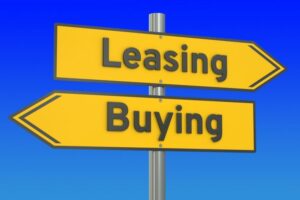The most important distinction between buying vs leasing is how the finance charges are paid.

If you have ever bought a house or a car, or started a business, you likely have experience with loans. A question you or your customer may be wondering is when to lease and when to buy using a loan? In this blog, we will compare the two.
A loan is ideal for collateral you want to own at the end of the term; something that holds its value past the life of the agreement. A lease is best for something that depreciates quickly – like technology – and will not hold its value past the term.
In a loan, the interest is amortized throughout the term. In other words, your customer is paying more interest at the beginning and more principal at the end.
Leasing isn’t free, but the finance charges are fixed throughout the term and are not paid separately from the borrowed amount.
Why Opt for Financing Over a Cash Purchase?
Before we more deeply explore the buying vs leasing analysis, let’s briefly address why one would use financing instead of cold, hard cash in the first place. If your customers need new hardware, software, upgrades, or add-ons, and they want to spend their available cash more effectively, financing is the answer. Plus, as the solution and/or service provider, you benefit by adding monthly recurring revenue (MRR). Financing also allows for a stickier customer.
The Traits of a Lease
What makes a lease unique?
- One fixed monthly payment
- Non-cancelable
- Good for equipment that loses value
- Inclusive of soft costs (installation, training, implementation)
- No advance payment or deposit required
- No impact on bank lines
- Easy to upgrade or add equipment throughout term
- Lease rates not tied to credit risks
What is a lease rate? A lease rate factor is represented as a fraction or multiplier and is used to quickly calculate a monthly payment.
The Traits of a Bank Loan
Similar to a lease, loans have distinct characteristics that make them different. It’s important to understand these nuances in effort to make the best recommendation for your customers. Here are some qualities that make a bank loan unique:
- Interest amortizes with more due at the beginning, and less at the end
- Rates can fluctuate and are tied to prime and economic factors
- Customer owns the equipment when loan is paid off
- The bank can put liens on customer assets as collateral
- Ties up customer’s business credit line and limits
- Limits customer’s ability to borrow for other investments
- Requires a down payment or deposit
- Inconvenient to upgrade or add additional equipment as needed
- Can be a rigorous approval and underwriting process
- Customers with less established credit may face higher rates
What is the Difference Between a $1 Buyout Lease and Bank Loan?
Similar to a $1 buyout lease, a loan for the equipment places the emphasis on ownership. In both cases, when the customer makes the final payment at the end of term, they will own the equipment and likely continue to use it.
When Does a Bank Loan Make Sense for a Customer?
A loan makes sense for customers who lack the need to use their bank lines for revenue-appreciating activities like marketing, hiring or inventory. It also makes sense if they plan to own and use equipment for a very long time. When equipment or technologies don’t have frequent improvements and upgrades, ownership could be the answer.
The best way to determine the right option for your customers is to consider the drivers behind their need to acquire the equipment. Below are a few qualifying questions to ask to determine the importance of their cash flow for the purchase:
- How long will the equipment be required?
- Will the equipment become obsolete while it’s still needed?
- How much cash would be required upfront for a lease or loan?
- Are there any new initiatives they want to undertake that will require working capital such as expanding, hiring or R&D?
The Verdict on Buying vs Leasing
Both leasing and loaning are wallet-friendly options for acquiring equipment. Yet, there are more distinctions between the two than you’d expect! When your customers instinctively say they don’t need to lease because they can use a bank loan instead, or they don’t need to finance because they have cash, you can highlight some of the differences and benefits to them.
Through a lease, your customer can invest cash and credit into other areas of their business. They can have a consistent interest rate with no down payment, and even better, avoid the act of investing into equipment that quickly becomes obsolete.
Do you have questions around buying vs leasing? Check out this FAQ from GreatAmerica Financial.
Ultimately, both an equipment lease and a bank loan help your customer obtain the equipment their business needs. The ability to pay over the course of a series of months is much more approachable than committing to a large, upfront cost. Maintaining working capital, hedging against inflation, and forecasting with ease are the cherries on top.
For a quick comparison between a lease, loan and cash you can keep on hand and share with your customers, check out this PDF from GreatAmerica Financial.
This article comes from our partners at GreatAmerica Financial. Read the full story here – What is the Difference between a Lease and a Loan?
Learn more about the Solutions360 integration with GreatAmerica Financial:

